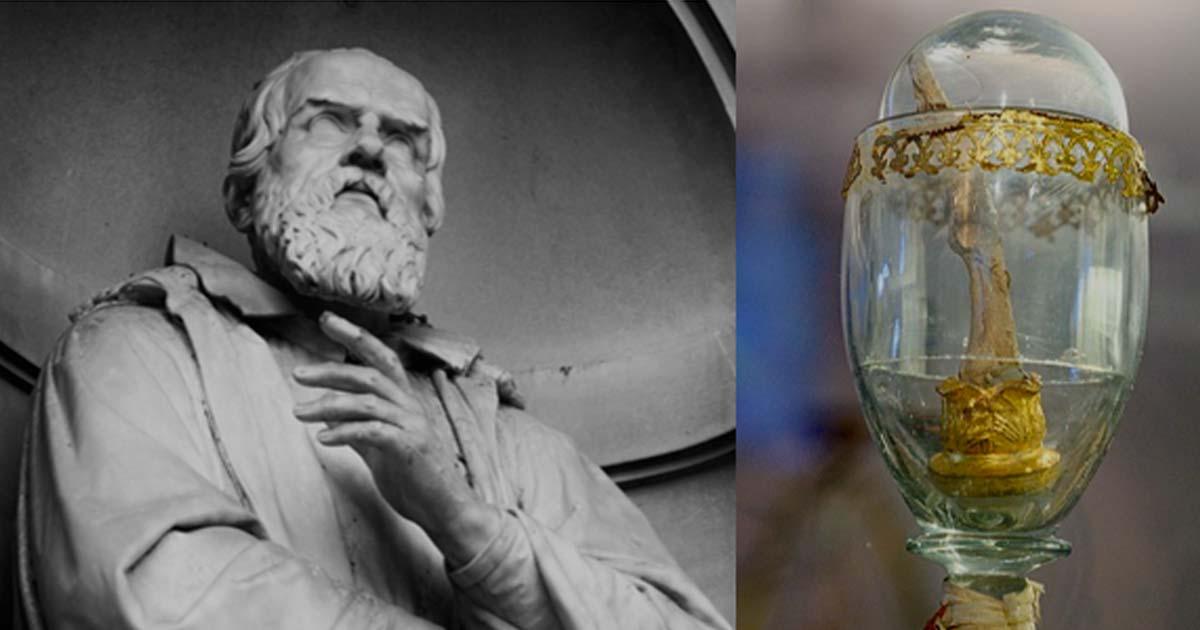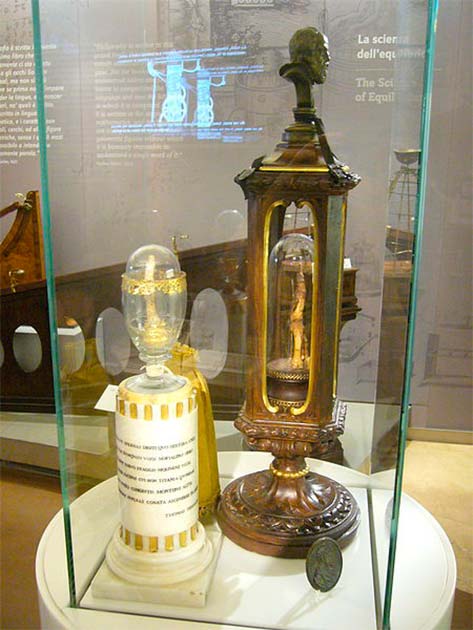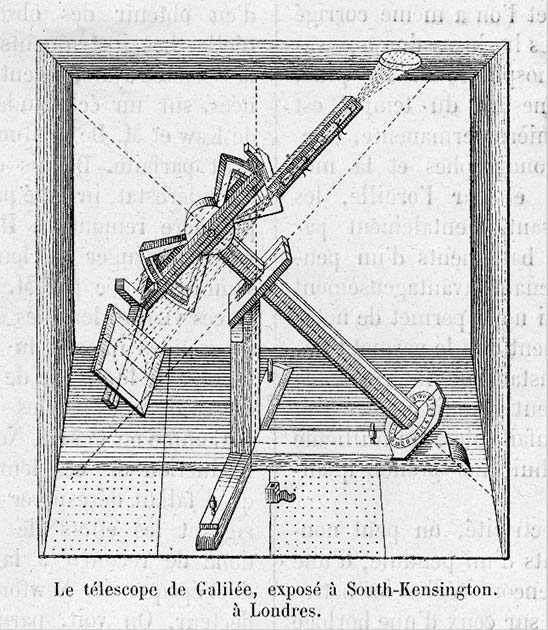
Galileo Gives the Finger: Defiance of the Catholic Church Immortalized
Who hasn’t heard of the legendary Renaissance era polymath, astronomer, physicist and engineer, who was declared a heretic by the Catholic Church - Galileo Galilei? The Italian’s defiance towards authority has been immortalized in the Galileo Museum in Florence, Italy, carefully and lovingly preserved by his admirers in an ornate and gilded glass bubble - the middle finger of Galileo!
So important is Galileo’s contribution to the annals of scientific history that one can safely say that science and discovery would not exist in the forms they do today without his brilliance and his defiance of the papal authorities. But what of the infamous middle finger?
Galileo Gives ‘Em the Finger: The Journey of Missing Fingers and Teeth
Today, Galileo's middle finger is enclosed within a small glass egg amidst lodestones and telescopes, standing as the sole human remnant in a museum exclusively devoted to scientific instruments. This detached finger would embark on a journey spanning centuries, being passed between hands until it ultimately found its resting place within the Florence History of Science Museum, now known as the Galileo Museum. Reaching this enclosed glass display was a circuitous route though, with several twists and turns.
Over two and a half centuries ago, on March 12, 1737, Italian antiquarian, history teacher, and priest, Anton Francesco Gori removed ‘the’ finger, a remarkable event that occurred 95 years after Galileo's passing. Galileo's remains underwent relocation from a small enclosure adjacent to the chapel of Saints Cosmas and Damian to the central area of the Santa Croce church. This move was to place them within a mausoleum constructed by Vincenzo Viviani. At this juncture, 3 fingers and his last remaining tooth from his lower jaw were excised.
In 2009, an auction unveiled two more fingers and a tooth attributed to Galileo. They were purchased and promptly brought to the Galileo Museum, which had been housing the middle finger since 1927.
Subsequently, two of these fingers along with the tooth were enclosed within a sealed glass container, which, at some point in the early 20 th century, vanished without a trace. These artifacts remained elusive for over a century until their recent reappearance at the museum. Galileo's middle finger now shares space with his index finger, thumb, and tooth, all enshrined within a bell jar, an ensemble that carries forward his legacy.
- Why Did the Spanish Inquisition Allow Some Witches to Stay Alive?
- That Old “Second Sphinx” Chestnut Is Back – Is There or Is There Not A Hidden Sphinx?

Middle finger of Galileo's right hand. (Museo Galileo/CC BY-SA 3.0)
The act of extracting body parts from a deceased individual echoed a tradition prevalent among saints, where Catholics held their digits, tongues, and organs in high esteem as relics possessing sacred attributes.
The irony is apparent - the fact that Galileo underwent a similar process, even as he faced persecution from the Catholic Church for endorsing the hypothesis that the Earth revolves around the Sun, contrary to the established belief at the time. This perspective stands in stark contrast to the Church's position. The Inquisition compelled him to retract his views and imprisoned him in 1634. What really happened though?
It's Blasphemy! The Galileo Affair
On June 22, 1633, Galileo Galilei faced proceedings at the headquarters of the Inquisition in Rome: the Roman Catholic Church versus the renowned scientist. Confronted with the dire prospects of torture, imprisonment, or even execution by burning at the stake, Galileo, while on his knees, was compelled to undertake a solemn act. He was coerced into "abjuring, cursing, and detesting" a lifetime's worth of brilliant and dedicated intellectual pursuit and effort.
At the ripe age of 69, Galileo invoked his "pitiable state of bodily indisposition" as part of his defense. The charges against him rested on accusations of "vehement suspicion of heresy." The trial demanded that he openly renounce, "with a heartfelt sincerity and unfeigned faith," his conviction that the sun, rather than the Earth, occupied the central position in the universe.
Owing to his age, he was placed under house arrest for life, for opposing the Church’s teachings, and found guilty of heresy. The question is, how did it reach this state?

Painting showing Galileo Galilei displaying his telescope to State and Church authorities. (Public Domain)
The Geocentric vs. Heliocentric Model: The Role of the Telescope
In 1543, the Polish astronomer Nicolaus Copernicus introduced the heliocentric, or sun-centered, model of the solar system: the planets in the solar system revolved around the sun. This was in contravention to the accepted Geocentric model, where the earth lay at the center of the universe, long accepted by the Catholic Church as ‘gospel’.
The reach of this work was limited: as long as the Heliocentric doctrine remained cloaked in Latin, seemingly just another verbose scholarly discourse with minimal readership or interest, the Church could safely disregard it. The work never found its way into the Index, a sign of its perceived ineffectiveness. This changed in 1616 when Galileo's endorsement of the Heliocentric concept compelled the Church to acknowledge the groundbreaking nature of Copernicus's idea.
The established perspective, ‘Geocentrism’, articulated around 150 AD by Ptolemy of Alexandria, an astronomer and geographer, entailed an astronomical framework that aimed to explain the apparent movements of celestial bodies. Ptolemy's system postulated Earth at the center of the universe, with the moon, sun, planets, and stars orbiting around it within a series of concentric crystal spheres. Ptolemy's model demonstrated pragmatic utility, enabling astronomers to accurately predict celestial motions. This system involved all bodies moving along circular paths.
Copernicus's revolutionary notion inverted Ptolemy's model. He deemed the Ptolemaic system excessively convoluted. Copernicus proposed an alternative: the sun at rest, while Earth engaged in a dual motion of rotating on its axis daily and orbiting the sun annually.
In their initial iterations, early telescopes primarily found utility on earth in functions like surveying and military strategy. However, a pivotal shift occurred when a select group of astronomers, including Galileo, directed these optical devices towards the heavens. Through refinement of the telescope's design, Galileo succeeded in creating an instrument with the capability to achieve magnifications of up to eightfold initially, and eventually pushing the limits to thirtyfold!

Telescope of Galileo Galilei. (Archivist/Adobe Stock)
Unlike his predecessors, Galileo saw the merit in publishing his ideas, hypotheses, and eventual observations. He utilized the availability of the printing press, which had started making its presence felt all over Europe. He also designed the prints in his books and was able to show the scientific community his finds, like his first treatise Siderius Nuncius in 1610, which showed the moon was a not a complete sphere, Jupiter had its own moons, and a rotating sun.
- Four Discoveries of Ancient Greek Astronomy That Still Baffle Experts
- The Dynamic Dance Of The Earth, Solar System, And Precession
Speculating on how Galileo might have regarded the ultimate resting place of his finger is complex. One might ponder whether the finger extends skyward, towards the heavens where Galileo glimpsed the splendor of the cosmos and perceived the divine in mathematics. Alternatively, it could symbolize a perpetual act of defiance against the church that once censured him—a decision left to the interpretation of the observer.
Top image: The statue of Galileo Galilei outside the Uffizi colonnade in Florence and Galileo’s middle finger, Museo Galileo, Florence. Source: BlackMac/Adobe/Stock, Zde/CC BY-SA 4.0
By Sahir Pandey
References
Clark, R. 2018. Galileo’s Middle Finger. Available at: https://www.standleague.org/newsroom/blog/galileos-middle-finger.html.
Conradt, S. 2015. More Than 375 Years After His Death, Galileo Is Still Pointing Fingers. Available at: https://www.mentalfloss.com/article/66378/373-years-after-his-death-galileo-still-pointing-fingers.
Greene, R.A. 2009. Galileo's missing fingers found in jar. Available at: https://edition.cnn.com/2009/WORLD/europe/11/23/galileo.fingers/index.html.
Markel, H. 2022. How Galileo’s groundbreaking works got banned. Available at: https://www.pbs.org/newshour/science/how-galileos-groundbreaking-works-got-banned.
Predavec, E. 2011. Galileo's Finger. Available at: https://www.wired.com/2011/04/galileos-finger/.















Comments
Another was burned at the stake in public at the sanction of the unholy catholic church for the same offence because he refused to recant. I believe his name was Bruno. The church witheld learning and inovation inatives for a 1000 years of darkness. .